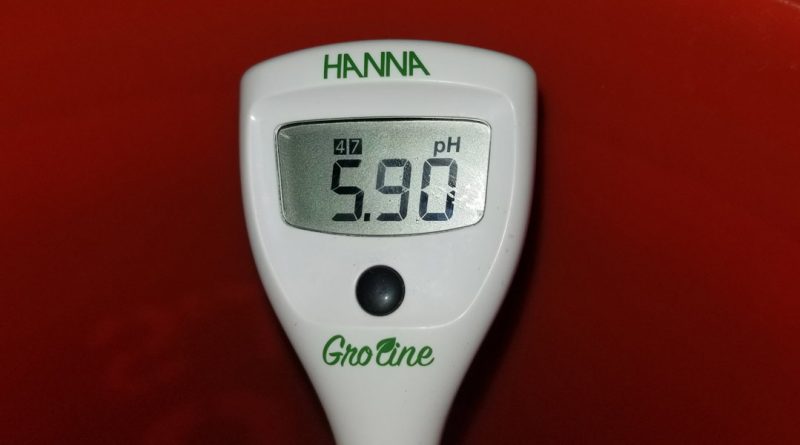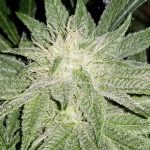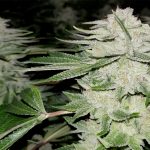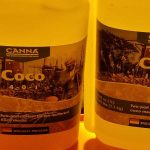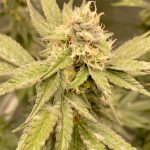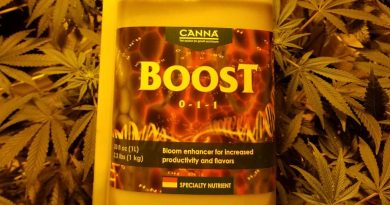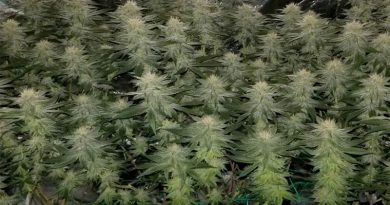Coco coir pH chart: What is the best pH for weed in coco coir?
The best pH for weed in coco coir is between 5.8 and 6.0 in the vegetation stage. The best coco pH for flowering is between 6.0 to 6.2. The max coco coir pH range you’d want is 5.5 to 6.5. Growing weed in coco outside of that pH range will cause nutrient uptake problems.
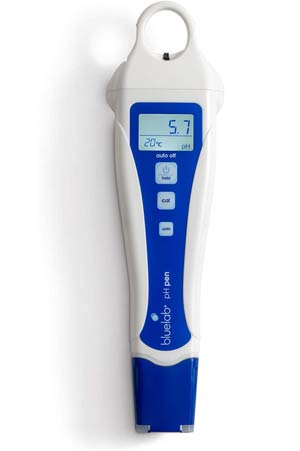
During the vegetative phase of weed plants your goal is to keep your nutrient solution at a pH of 5.8 to 6.0. This is the best pH for proper nitrogen absorption by marijuana plants in vegetation. Varying the pH occasionally in veg from 5.6 to 6.2 helps other nutrients that are best absorbed at slightly higher or lower pH levels.
You want to go a bit higher with your coco pH range during flowering to allow for better absorption of phosphorus and potassium. We like to aim for 6.0 to 6.2, with a range of 5.8 to 6.3.
A good pH pen is essential. It’s one of the most important tools to ensure a successful grow in coco coir.
- The Bluelab pH pen (usually $70-$90) is the best pH pen for weed that we’ve used. Highly accurate, it’s preferred by most growers.
- The Hanna pH pen ($30 range) is the best pick for budget-minded growers . We used these for many years and they worked well. Don’t let the bulbs dry out, there’s no sponge in the storage cap to hold moisture like with Bluelab’s pen.
- The more accurate +/-0.1 Accuracy Hanna pH Meter ($42-$60) is usually cheaper than the Bluelab.
Note that pricing for these can vary pretty heavily week-to-week on Amazon.
Watering to runoff
You should always water your coco coir to runoff. Aim for 10-20% to drain out the bottom of your container.
This ensures the roots get fully saturated and the runoff removes excess nutrient salts that could lead to nutrient burn if you’re over-fertilizing.
Never let your containers sit in this runoff. Use a plastic plant stand to elevate the plant containers. Use a round plant tray underneath each plant to get above the runoff to avoid issues.
A shop vac can remove water that accumulates in your plant trays. The Bucket Head wet/dry vac fits on 5 gallon buckets and is perfect for sucking up runoff. It holds a lot more than other cheap small bucket vacs.
You can automate the runoff drainage by setting up a fiberglass hydro drain table to remove runoff to an external drain. We use a 4’x4′, but they also make 2’x2′, 2’x4′, 3’x3′, 4’x8′, etc.
Measuring the pH of the runoff water
If you suspect you’re having deficiencies caused by pH issues in coco coir, you can try measuring runoff pH to see where you fall on the coco pH chart.
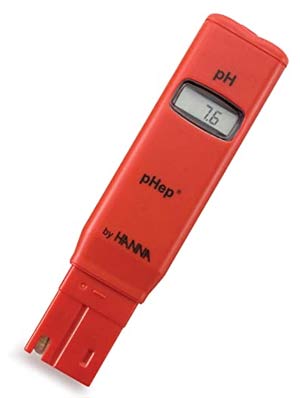
Measuring the pH of the runoff water helps you understand if you’re running the best pH for weed at your plants’ root zone. If your runoff pH is too low or too high on the coco pH chart, you can adjust your next waterings to bring it back closer to the proper range.
If you find your coco coir pH is way off, flush a bunch of properly pH’d nutrient solution through your plant to get things back in line. Aim for a very slow watering with lots of runoff through the coco coir. Don’t water too quickly or water may just drain through the sides of fabric pots.
Keep in mind that separate plants need to be monitored independently, especially if running different strains. Nutrient requirements can vary across different types of weed.
You should also be using a ppm meter to measure total dissolved solids while you’re measuring the runoff coco pH. If your TDS is too high that will lead to issues as well.
Don’t go nuts spending all your time chasing runoff pH. It’s a tool available if you suspect pH problems with your weed plants. But spending hours tracking runoff if your plants seem otherwise healthy isn’t the best use of your time unless you’re really seeing issues.
Help! I’ve really fucked up my coco coir pH!

If you have really fucked things up with the pH in your substrate and your coco coir pH is off the chart then you may need to take more decisive action.
Slowly flush with 2x to 3x your container size of plain 5.8 pH’d water to really flush it out. Monitor runoff pH.
Then an hour later mix up nutrient solution (5.8 for vegetation or 6.0 for flowering). Water slowly to runoff. If your runoff is back in range then you’re good to go. If not, keep watering until it is.
It’s better to do this slowly to ensure that all the coco in your container is properly addressed. If you go too fast the flush water may just pour through areas of the root ball with the lowest density, or through the sides of fabric pots, reducing effectiveness of the flush.
After you’ve completed a flush with plain water (no nutrients) the coco coir will be saturated with water that is devoid of nutrients. So you’ll need to mix up your nutrient mix and re-water slowly until heavy runoff to ensure your plants don’t go hungry.

How to fix pH problems in weed plants grown in coco coir
Thankfully it’s pretty easy to fix pH problems in weed plants growing in coco coir. Especially if you catch them early. For the most accurate results, test the pH of the coco’s runoff water to see how things are going inside the root ball.
Too high or too low pH levels will prevent the marijuana roots from being able to absorb necessary nutrients, causing nutrient lockout. Weed plants suffering from nutrient lockout will show signs of damage, so monitor your plants daily and look for unusual symptoms.

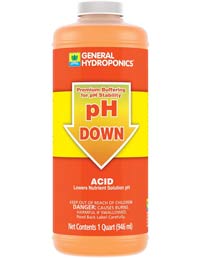
How to lower coco coir pH
If your runoff pH is too high or too low, you can fix pH issues easily by flushing the coco coir with properly pH’d water. Use pH Down or a similar product to adjust the level to within the coco pH chart.
For example, if your runoff shows a slightly high pH of over 6.2, try running the next few waterings around 5.6 to 5.7 with about 25-30% runoff and you can bring this down easily.
For major pH issues such as a pH over 6.5, you’re entering the danger zone and you should flush several gallons per plant container at 5.6 to make sure to correct the issue more quickly. Then resume watering at 5.8 – 6.o once things are back to normal.
You’ll need to use pH down every time you water. Use a 3 ml plastic eye dropper to dispense it.

How to raise coco coir pH
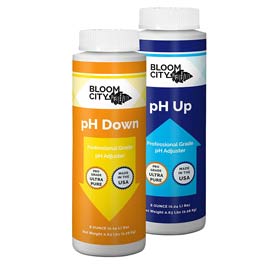
If the pH of your runoff water is too low, say 5.6 or below, you can raise your coco coir pH in a similar manner by flushing.;
Flush with water pH’d around 6.3 or so for low pH problems. Your goal is to flush slowly, so apply the water in small amounts at first to let it absorb into your coco medium, and then continue to add water slowly so it drips out of the bottom.
Once the runoff pH is back above the 5.7 mark you’re in good shape. Keep an eye on the runoff going forward to try and keep it within range of the best pH for weed.
Botanicare pH Up or similar products can help you adjust your water to the proper pH if you overdo it with the pH down. You generally won’t use a lot of pH Up compared to pH Down.
If you need to buy both, the Bloom City pH Up and Down set is a good option to consider as well.
How to test pH in coco coir
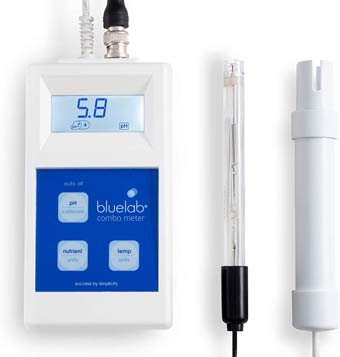
A good pH meter is well worth the investment to test pH in coco coir nutrient solution. Consider the BlueLab pH pen ($70-90) which is the best choice. It’s very accurate, fully waterproof, and is the standard tool used by most home growers.
Incorrect coco coir pH levels are the biggest cause of cannabis plant health problems among new weed growers. One of the important growing in coco tips is to maintain an accurate pH every time you water. Don’t guess at it.
Get a decent pH meter, adjust using a small amount of pH up or down using a dropper, stir gently, and test again until you get it in the zone. Eventually you’ll start to learn about how much you’ll need each time.
Wiggle your pH meter around in the water gently to get the reading to calibrate quicker. Watch for older meters with readings that slowly keep climbing, if this happens it’s time to recalibrate and it may be a sign you’ve fried the bulb and it needs to be replaced. It’s impossible to maintain your plants in the proper range on the coco ph chart if your meter is giving incorrect readings.
How to store a pH meter
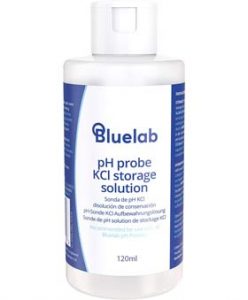
Make sure to properly store it by adding pH meter storage solution (or clean water) to the cap and replacing it over the pH bulb after each use. Never let the bulb of your pH meter dry out, it will stop working correctly and you’ll need to replace it.
In our experience this can happen a lot if you’re not careful − especially if you’re smoking a jay while you work and you get distracted. Try to have good habits to avoid this, and make sure you replace the cap right away when you’re done using it..
Recalibrate your pH meter frequently
Most pH meters come with a few envelopes containing calibration solution for the first time you do it. You can pick up a pH meter calibration solution kit once you’ve used those up.
Every 3 months you should recalibrate your pH meter according to the instructions it came with to ensure accurate readings. Doing this at the start of every new grow is a good habit to get into.
If you don’t recalibrate your pH meter you will end up giving improperly pH’d water to your weed plants and you’ll end up with nutrient deficiencies. Fix these problems early in vegetation so that your plants are at optimal health levels when you flip them into flower.
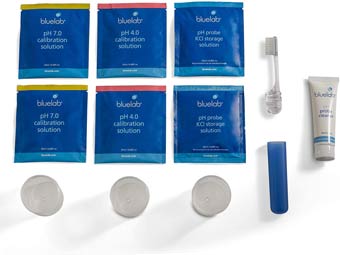
I’ve heard from several growers who were running into-head scratching pH issues in coco coir that were resolved through a simple meter calibration. It’s much cheaper to calibrate than to buy a new meter.
Summary: The best pH for weed in coco coir
The best coco coir pH for cannabis nutrient solutions is between 5.8 and 6.0 in vegetation and 6.0 to 6.2 in flowering. Try to keep the coco coir medium at a pH of 5.8-6.2. Alternate the pH of waterings within the range of the coco pH chart.
Water to runoff of 10-20%, and monitor the pH of this runoff to address issues. For small issues just adjust your next watering. Correct bigger issues with too high or too low pH levels in coco coir by flushing your marijuana plants with properly pH’d nutrient solution. Try to follow the coco pH chart for weed each time you water to stay free of issues.

